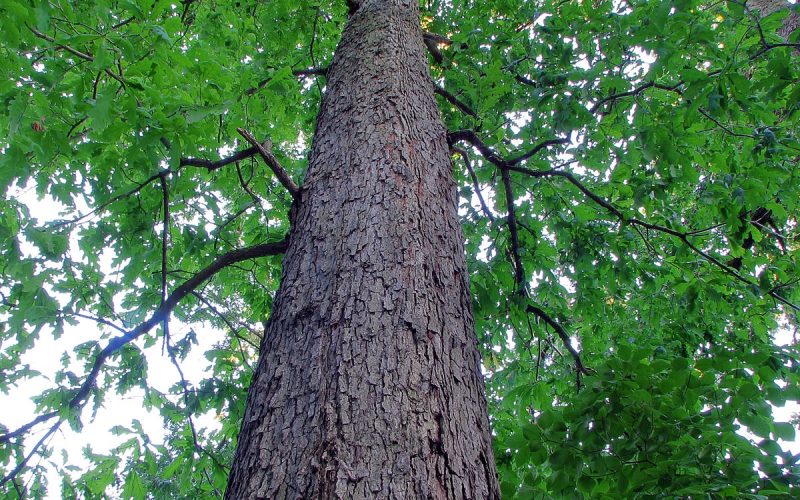White oak, also referred to as Quercus alba, is one of the predominant hardwoods that dominates the central and eastern parts of North America.
It can also be found in parts of Quebec, Ontario, Minnesota, southern Maine, east Texas and northern Florida.
While it is referred to as white oak, finding a single specimen with white bark is very unusual. White oaks are generally characterized by their grey barks which are derived from the finished wood it displays.
Scientific Classification
| Kingdom | Plantae |
| Clade | Tracheophytes, Eudicots, Rosids |
| Order | Fagales |
| Family | Fagaceae |
| Genus | Quercus |
| Subgenus | Quercus subg. Quercus |
| Section | Quercus sect. Quercus |
| Species | Q. alba |
| Binomial name | Quercus alba |
Growth and Size
A typical white oak or Quercus alba can measure between 80 to 100 feet (24 -30m) when fully matured. The most prominent white oaks measured up to 150 feet while the trunk diameter measured about 4 feet.
It is a slow-growing tree that can live for a hundred years. Due to its slow-growing rate, the tree is complicated to transplant. The height of white oak can reach up to 12 in – 24 in per year, even with its slow-growing nature, its still a precious gift of nature.
There are older specimens known to have lived up to 200 to 300 years, and an example is the Wye Oak in Wye mills Maryland which lived for about 450 years.
The colour its leaves produced varies with the season and can come in dark green to blue-green in summer, brown, wine-red to orange-red in fall.
Its 20th year hits the clock-mark of full sexual maturity, but it does develop many groups of acorns until its 50th year. Its fruit, which is the acorn, has a short life span, which means it degenerate after ripening.
Thankfully, acorns serve as an excellent source of food for animals and insects.
Uses
Medical
The bark of the tree is medicinal. It contains tannins which help in the treatment of diarrhoea and inflammation. It is used as a tea to cure various illness such as arthritis, diarrhoea, colds, fevers, cough, and bronchitis.
It is used for stimulating appetite and for aiding digestion. White oak can be applied directly on the skin, either compressed or added it to the bathwater for inflammation of the skin, mouth, throat, genitals and more. It can be applied to red itchy skin due to cold exposure.
Woodwork
White oak contains tyloses which make the cellular system structure closed, making it have resistance to water and rot.
This distinct trait makes it an excellent option for coopers to choose for various purposes. It is utilized for the construction of ships, barrels for whiskey and wine. It is also used for interior finishing of households.
The tree can be used for Japanese martial arts weapons because of its resiliency, strength, and density such as nunchucks, bokken, and jo.
Musical Instrument
White oak is used to make banjo of 5-strings, drumsticks and the production of a guitar.
Wildlife
The tree is a necessity in the wildlife because it produces acorns which serve as a valuable source of food for insects and animals such as turkeys, woodpecker, squirrel, deer and many more.
Precautions
- White oak isn’t recommended for pregnant or nursing mothers, so it is advised that they stay clear of it
- People with existing liver or kidney disease shouldn’t take it
- Parents should also endeavour to keep it away from their children
- White oak shouldn’t be taken by patients with heart conditions or applied directly on the skin
Side effects
- Liver or kidney damage
- Nausea and some other stomach problems
- Viral infections can cause damage to the Lungs
Uses
- It helps to minimize the risk of viral and bacterial infections
- It boosts the body’s ability to fight against infections
- It minimizes the risk of infectious diseases
- It can be used externally to get rid of skin disorders and insects bites
- Its antiseptic factors can be used to treat skin bruises, rashes, and vaginal discharge
- The oil is used in the treatment of burns, eczema, and cuts
- Herbs produced from white oak can be used to treat oral issues like toothache and gingivitis
- Gargles are beneficial for mouth ulcers and bleeding gums
- Anti-inflammatory factor decreases the inflammation linked with cough and bronchitis
- The extract gotten from the white oak tree is used to reduce the phlegm and treats cold
- It is useful in treating throat infections and asthma
- It helps to prevent the development of initial symptoms of chilblains
- It helps to stop internal and external bleeding
- It contracts the body tissues and restores their elasticity
- White Oak is an excellent herbal for treatment for diarrhoea and haemorrhoids
- White oak is used to treat nose bleeding and vomiting
- It regulates the menstrual cycle. It eases the flow of blood in immense menses
- It is also helpful in varicose veins
- It reduces the itching associated with genital problems
- It helps in regulating kidney functions
- It minimizes the risk of bladder infections by flushing out kidney stones
- It stimulates urination and clears urinary passages
- Oils obtained from pressed acorns are used to alleviate pain in the joints.
- It can also be applied topically in the form of a bath or compress to treat poison ivy rashes, bites, burns and minor wounds
If further assistance is needed, please see a doctor at the nearest hospital.
Sources;








